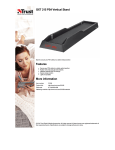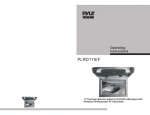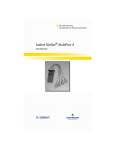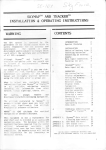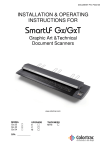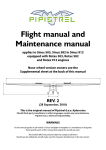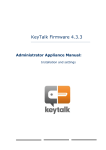Download GXT 3x1
Transcript
UPSTATION GXT TM 3x1 6-8-10 kVA User Manual Manual Reference number : 6390010Q En (06/02) D DRR This manual describes the following GXT Series UPS models: EQUIPMENT PART NUMBER 6 kVA GXT 3x1 UPS GXT3X1-6000 8 kVA GXT 3x1 UPS GXT3X1-8000 10 kVA GXT 3x1 UPS GXT3X1-10000 IMPORTANT All models in the UPS range are similar in both operation and use. If you encounter any problems with the procedures contained in this manual you should seek immediate assistance from the Liebert Sales Office from whom the equipment was purchased. Alternatively, contact the Liebert's Customer Service & Support department at the address shown below: Liebert Hiross United Kingdom Customer Service and Support Department 4th Avenue, Globe Park Marlow-SL7 1YG Buckinghamshire Telephone +44 1628 403200 Fax +44 1628 403203 This department also arranges service contracts and full commissioning service. (06/02) Page iii UPStation GXT 3x1 Page iv USER MANUAL (06/02) USER MANUAL UPStation GXT 3x1 IMPORTANT SAFETY INSTRUCTIONS IMPORTANT SAFETY INSTRUCTIONS WARNING: Opening or removing the cover may expose you to lethal voltages within this unit even when it is apparently not operating and the input wiring is disconnected from electrical source. Observe all cautions and warnings in this manual. Failure to do so MAY result in serious injury or death. Refer all UPS and battery service to qualified service personnel. Do not attempt to service this product yourself. Never work alone. 1. SAVE THESE INSTRUCTIONS. THIS MANUAL CONTAINS IMPORTANT SAFETY INSTRUCTIONS. Read all safety and operating instructions before operating the Uninterruptible Power System (UPS). Adhere to all warnings on the unit and in this manual. Follow all operating and user instructions. This equipment can be operated by individuals without previous training. 2. This product is designed for Commercial/Industrial use only. It is not intended for use with life support and other designated “critical” devices. Maximum load must not exceed that shown on the UPS rating label. The UPS is designed for data processing equipment. If uncertain, consult your dealer. See Limited Warranty. 3. This UPS is designed for use on a properly earthed (grounded), 208-240 VAC, 50Hz or 60Hz supply, for installation by qualified personnel. A qualified electrician must review and approve customer supplied wiring, circuit breakers, intended loads, and verify correct input, output and earth connections to ensure compliance with technical standards and local electrical codes of practice. Installation instructions and warning notices only for use by qualified personnel are located after the UPS operator instructions in this manual. 4. ELECTROMAGNETIC COMPATIBILITY- The GXT3x1 6 & 8 & 10 kVA , complies with the limits for a Class A digital device, pursuant to EN50091-2 rules. These limits provide reasonable protection against harmful interference in a commercial environment. This device generates, uses, and radiates radio frequency energy and, if not installed and used in accordance with the instruction manual, may cause harmful interference to radio communications. Operating this device in a residential area is likely to cause harmful interference, which the user must correct at his own expense. 5. Operate the UPS in an indoor environment only in an ambient temperature range of 0°C to +40°C (32°F to +104°F). Install it in a clean environment, free from moisture, flammable liquids, gasses, or corrosive substances. 6. This UPS contains no user serviceable parts. The UPS ON/OFF pushbuttons do not electrically isolate internal parts. Under no circumstances attempt to gain access internally, due to the risk of electric shock or burn. Do not continue to use the UPS if the front panel indications are not in accordance with these operating instructions, or the UPS performance alters in use. Refer all faults to your dealer. 7. Only trained engineers authorized by Liebert should perform troubleshooting. To replace batteries, refer all servicing to qualified service personnel. PROPER DISPOSAL OF BATTERIES IS REQUIRED. REFER TO YOUR LOCAL LAWS AND REGULATIONS FOR DISPOSAL REQUIREMENTS. 8. Never block or insert any object into the ventilation holes or other openings. 9. DO NOT CONNECT equipment that could overload the UPS or demand DC current from the UPS, for example: electric drills, vacuum cleaners, laser printers, hairdryers or any appliance using half wave rectification. 10. Storing magnetic media on top of the UPS may result in data loss or corruption. 11. Turn the UPS off and isolate the UPS before cleaning. Use only a soft cloth, never liquid or aerosol cleaners. Keep the front and rear vents free of dust accumulation that could restrict airflow. (06/02) Page v UPStation GXT 3x1 USER MANUAL GLOSSARY OF SYMBOLS Indicates AC Input Indicates AC Output Indicates Caution: Note the accompanying instruction Indicates the position of a fuse Requests the user to consult the manual for additional information Indicates that the unit contains a valve regulated lead acid battery Page vi (06/02) USER MANUAL UPStation GXT 3x1 EEN NG GLLIISSH H Table of Contents 1 GENERAL DESCRIPTION .........................................................................................................................................1 1.1 Introduction ..............................................................................................................................................................1 1.2 Major components....................................................................................................................................................1 1.2.1 EMI/RFI filters ....................................................................................................................................................1 1.2.2 Rectifier/Power Factor Correction (PFC) circuit................................................................................................2 1.2.3 Inverter.................................................................................................................................................................2 1.2.4 Battery Charger ...................................................................................................................................................2 1.2.5 Battery .................................................................................................................................................................2 1.2.6 Static Bypass .......................................................................................................................................................2 1.2.7 Auto re-start.........................................................................................................................................................2 2 INSTALLATION..........................................................................................................................................................3 2.1 2.2 2.3 2.4 2.4.1 2.4.2 2.4.3 2.4.4 2.4.5 2.4.6 2.4.7 2.5 2.5.1 Installation considerations........................................................................................................................................3 Unpacking and inspection ........................................................................................................................................3 Location....................................................................................................................................................................3 Electrical installation considerations........................................................................................................................4 Electrical Connections.........................................................................................................................................4 Connecting the UPS power cables ......................................................................................................................5 Connection of optional remote battery cabinets..................................................................................................5 Stabilisers/Levelling feet .....................................................................................................................................6 Ferrite bead installation .......................................................................................................................................7 Serial Communications .......................................................................................................................................7 SNMP Installation ( When fitted) .......................................................................................................................7 Commissioning the UPS ..........................................................................................................................................8 Output Voltage Selector Switches.......................................................................................................................8 3 CONTROLS AND INDICATORS............................................................................................................................ 11 4 OPERATING MODES .............................................................................................................................................. 13 4.1 Introduction ........................................................................................................................................................... 13 4.1.1 Normal mode operation- UPS mode................................................................................................................ 13 4.1.2 Battery mode operation .................................................................................................................................... 13 4.1.3 Bypass mode operation .................................................................................................................................... 14 4.1.4 Output off mode operation ............................................................................................................................... 14 4.1.5 Manual operation with mains available ........................................................................................................... 14 4.1.6 Starting the UPS with mains available ............................................................................................................. 14 4.1.7 Powering down the UPS with mains available ................................................................................................ 15 4.1.8 Alternate quick powering down the UPS......................................................................................................... 15 4.1.9 Manual operation without mains...................................................................................................................... 15 4.1.10 Powering up the UPS without mains................................................................................................................ 15 4.1.11 Powering down the UPS without mains........................................................................................................... 15 4.1.12 UPS Remote shutdown option. ........................................................................................................................ 16 5 5.1 5.2 5.3 5.4 5.5 6 6.1 6.2 6.3 COMMUNICATIONS............................................................................................................................................... 17 UPS Monitoring .................................................................................................................................................... 17 UPS Intelligent Communications.......................................................................................................................... 17 UPS Intellislot™ Communications....................................................................................................................... 17 SNMP Web Card .................................................................................................................................................. 17 Communications Interface Port............................................................................................................................. 18 TROUBLESHOOTING............................................................................................................................................. 19 Audible Alarm Conditions .................................................................................................................................... 20 Troubleshooting guide........................................................................................................................................... 20 Maintenance .......................................................................................................................................................... 21 (06/02) Page vii UPStation GXT 3x1 7 7.1 USER MANUAL SPECIFICATIONS .................................................................................................................................................... 23 Limited Warranty................................................................................................................................................. 24 Page viii (06/02) UPStation GXT 3x1 1 Chapter 1 – General Description Design Concept GENERAL DESCRIPTION 1.1 Introduction Congratulations on your choice of the UPStation GXT™ Uninterruptible Power System (UPS). It provides conditioned power to microcomputers and other sensitive electronic equipment. Upon generation, AC power is clean and stable. However, during transmission and distribution it may be subject to voltage sags, spikes, or complete power failure, which may interrupt computer operations, cause data loss, or even damage equipment. The UPStation GXT protects equipment from these disturbances. The UPStation GXT is an “on-line” UPS that continuously conditions and regulates its output voltage, whether the mains power is present or not. It supplies connected equipment with clean sinewave power. Sensitive electronic equipment operates best from sinewave power. The GXT 3x1 -230X models have an additional output isolation transformer. For ease of use, the UPStation GXT contains a light emitting diode (LED) display to indicate either “load percentage” or “battery capacity” depending upon the mode of operation. It also provides self-diagnostics, a combination On/Alarm Silence/Manual Battery Test button, a combination Off/Bypass button, and two levels of alarms when the unit is operating on battery. The UPStation GXT has an interface port for communications between the UPS and a LAN server or other computer system. This port provides detailed operating information including voltages, currents, and alarm status to the host system when used in conjunction with the SiteNet® 2 software. SiteNet® 2 software can also remotely control UPS operation. 1.2 Major components Figure 1-1 1.2.1 EMI/RFI filters These UPS components provide surge protection, and filter both electromagnetic interference (EMI) and radio frequency interference (RFI). They minimize any surges or interference present in the mains line and keep the sensitive equipment protected. (06/02) Page 1 Chapter 1 – General Description Design Concept UPStation GXT 3x1 1.2.2 Rectifier/Power Factor Correction (PFC) circuit In normal operation, the rectifier/power factor correction (PFC) circuit converts mains AC power to regulated DC power for use by the inverter, while ensuring that the wave shape of the input current used by the UPS is near ideal. Extracting this sinewave input current achieves two objectives: the mains power is used as efficiently as possible by the UPS, and the amount of distortion reflected on the mains is reduced. This results in cleaner power being available to other devices in the building not being protected by the UPStation GXT. 1.2.3 Inverter In normal operation, the inverter utilises the DC output of the power factor correction circuit and “inverts” it into precise, regulated sinewave AC power. Upon a mains power failure, the inverter receives its required energy from the battery through the rectifier / PFC. In both modes of the operation, the UPS inverter is on-line and continuously generating clean, precise, regulated AC output power. 1.2.4 Battery Charger The battery charger utilises energy from the Rectifier / PFC and precisely regulates it to continuously “float” charge the battery system. The battery system charges whenever the UPStation GXT is connected to mains power. 1.2.5 Battery The UPStation GXT employs valve regulated, non-spillable, lead acid batteries. At typical room temperatures and with the UPS float charging, the battery system will last many years. Optional external battery cabinets are available to provide extended run times. 1.2.6 Static Bypass The UPStation GXT provides an alternate path for mains power to the connected load, in the unlikely event of a UPS malfunction. Should the UPS have an overload, over temperature, or UPS failure condition, the UPS automatically transfers the connected load to BYPASS providing the bypass voltage is within specification. BYPASS operation is indicated by an alarm and an illuminated BYPASS LED (other LED’s may be illuminated to indicate the diagnosed problem). To manually transfer the connected load from the inverter to BYPASS power, press the output OFF button once. NOTE: The BYPASS power path does NOT protect the connected equipment from disturbances on the mains supply and its range of operation is limited to +/- 15% of the nominal input supply voltage. 1.2.7 Auto re-start Upon restoration of the mains AC power after a mains power outage and complete battery discharge, the UPS will automatically restart and supply power to the critical load and the battery charger automatically recharges the battery. Page 2 (06/02) UPStation GXT 3x1 2 Chapter 2 - Installation INSTALLATION These instructions are for use by competent personnel only. 2.1 Installation considerations Detailed instructions to help you install the UPS are provided in the following pages; however, you should give some consideration to the proposed environment in which the UPS is to be installed, and carry out some preparatory work. 2.2 Unpacking and inspection Before you install the UPS, give it a thorough visual examination to ensure it has not been subjected to shipping damage. If it is not in perfect condition, you should advise both the shipper and the supplier immediately. DO NOT ATTEMPT TO INSTALL A DAMAGED UPS. Before disposing of the UPS packaging, check that you have removed to a safe place the user manual and any other items shipped with the unit to be used in its installation. CAUTION GXT3x1-6kVA UPS weighs up to 227kg (500 lbs)- GXT3x1-8&10 kVA UPS weighs up to 284kg (626 lbs). Use adequate handling aids when moving or installing the UPS. The UPS is fitted with castor wheels for easy movement. Take care when the UPS is removed from its packing and being wheeled across an uneven floor without the stabilisers fitted, that it does not tip over. Follow the instructions in Chapter 2 - Stabilisers/Levelling feet IMPORTANT Check the UPS rating plate that the UPS is suitable for operation on your MAINS voltage and load voltage requirements before installing. 2.3 Location Locate the UPStation GXT indoors in a controlled environment, where it cannot be accidentally disconnected. Locate it in an area with unrestricted airflow, away from water, flammable liquids, gases, corrosives, or conductive contaminants. Air vents are located at the front and rear of the UPS. Give consideration to the airflow requirements- (see below)- and allow at least 150mm (6inches) free space around the UPS, with a minimum of 300mm (12inches) at the back to enable easy operator access to the rear panel mounted input/output/battery circuit breakers. Electrical maintenance/servicing requires access to both sides of the UPS, provide the necessary free space or use a flexible wiring system to allow the UPS to be pulled forward. Maintain an ambient temperature range of 0 - +40° centigrade (32-104° F) NOTE- UPS operation in temperatures above 25°C (77°F) reduces battery life. Model # GXT3x1-6 kVA GXT3x1-8 kVA GXT3x1-10 kVA Airflow Cfm 130 270 270 Dissipation* 3 mh 221 459 459 Watts 504 840 840 K Btu/hr 1.7 2.8 2.8 Output Rating** VA 6000 8000 10000 Watts 4200 5600 7000 Table 2-1 (06/02) Page 3 Chapter 2 - Installation 2.4 UPStation GXT 3x1 Electrical installation considerations This UPS must be installed by competent electrical personnel and wired in accordance with local/national electrical codes. The following information is provided for your guidance. IMPORTANT EARTH CONNECTION IS ESSENTIAL BEFORE CONNECTING THE MAINS SUPPLY. Earth in accordance with local electrical codes. CAUTION This UPS is fitted with EMC suppression filters. Earth leakage exceeds 35mA. Transient and steady state earth leakage currents, which may occur when starting the UPS, should be taken into account when selecting instantaneous RCCB or RCCD devices. Note also that the earth leakage currents of the load will be carried by this RCCB or RCCD. CAUTION This UPS does not incorporate automatic backfeed protection. A warning label must be fitted to all primary power isolators stating: ISOLATE UNINTERRUPTIBLE POWER SYSTEM BEFORE WORKING ON THIS CIRCUIT. On start-up, the UPS will take a half cycle inrush current of up to 6 times the rated current. This must be taken into account when selecting the overload protection device at the input mains supply distribution point. To avoid random tripping on start-up, we recommend that the input mains supply be protected with an MCB capable of withstanding this initial inrush. An MCB specified as being “TYPE 4” (British standard) or “CURVE D” (IEC standard) is suitable for this purpose. The mains input supply cable must be connected to the UPS via a wall mounted double pole circuit breaker, rated to carry the current and be capable of breaking the maximum prospective short circuit current of this branch circuit. The breaker is to be mounted within two metres of the UPS and be readily accessible to the operator. 2.4.1 Electrical Connections The UPS is supplied with an input/output/ battery terminal block assembly on the rear of the UPS within a cable box (see outline drawing). The cable box can be removed to enable knockouts to be removed or new holes drilled, to secure the cables. The cable sizes and distribution methods used during installation are subject to local/ national electrical codes of practice , and therefore are not detailed here. The following tables detail the standard current ratings. The UPS rating plate gives details of the current ratings for alternative output voltages. The terminals will accept wire sizes up to the values below: Model Cables sizes INPUT CURRENT Amps max Including mains variation/battery charge GXT3x1-6000 10 mm2 GXT3x1-8000 16 mm2 GXT3x1-10000 16 mm2 Page 4 normal mode: 8A bypass mode: 26A normal mode: 11A bypass mode: 35A normal mode: 13A bypass mode: 44A (06/02) UPStation GXT 3x1 Chapter 2 - Installation 2.4.2 Connecting the UPS power cables Power cables connect to screw terminals on a terminal block that is located behind the rear mounted cable box (see figure). Permanent wiring must be routed to the cable box using appropriate materials as required by local codes. The cables enter the UPS through a Gland Plate attached to the rear of the UPS. The Gland Plate must first be removed and drilled to suit the glands or bushes for the cables used. Ensure that the glands are sized so that they hold the cables securely. UPS Power Section To Mains To Load To External Battery (Optional) 6-8-10 kVA Figure 2-1 Safety earth cable Properly grounded (earthed) equipment provide multiple benefits. High quality ground (earth) connections are required for the equipment ground conductors (protective earth) and grounding electrode conductor (power system earth connection) to reduce electrical noise and provide for safe operation of the UPS and connected loads. Conduit used alone without a grounding conductor wire is not an acceptable connection. Size ground (protective earth) conductors equal to circuit conductors. 2.4.3 Connection of optional remote battery cabinets Full installation instructions are provided with these cabinets. Safety/EMC certification limits the use of these terminals to Liebert supplied options. (06/02) Page 5 Chapter 2 - Installation UPStation GXT 3x1 2.4.4 Stabilisers/Levelling feet When the UPS is located in its final position before or after wiring, it is necessary to fit stabiliser brackets and, if necessary, adjust the levelling feet. If the UPS is wired using a rigid wiring system, then movement of the UPS must be prevented by winding down the 4 levelling feet under the UPS as shown below. For UPS wired with flexible cables, this is optional. Note: - Access to the levelling feet is obstructed by the stabiliser brackets, on the GXT 3x1 - 6000/8000/10000 models. Adjust the levelling feet as necessary using a 12mm open ended spanner/wrench. DO NOT LOOSEN THE LARGER NUT ABOVE, AS THIS FIXES THE LEVELLING FEET TO THE CHASSIS. Attach the stabilising brackets as follows. GXT3x1-6000, GXT3x1-8000, GXT3x1-10000 models: 1 Using a Phillips-head screwdriver, remove the three inner-most screws at the base of both side panels. 2 Attach the stabilisers fixing with the screws just removed. 12 mm Figure 2-2 Levelling Feet Adjustment Diagram Page 6 (06/02) UPStation GXT 3x1 Chapter 2 - Installation 2.4.5 Ferrite bead installation When using either of the options below, to reduce the risk of radio interference, fit the ferrite assemblies supplied with the UPS as follows: 2.4.6 Serial Communications Attach the smaller enclosed ferrite bead clamp to the communication cable as shown in the drawing using the following directions: • • • • Open the ferrite bead. Place the communication cable inside the ferrite bead groove. Position the ferrite beads as close as possible to the end of the cable that connects to the DB9 connector of the UPS. Close the ferrite bead so that the ferrite bead’s case snaps closed with the cable routed inside the ferrite bead’s case. 2.4.7 SNMP Installation ( When fitted) Attach the larger enclosed ferrite bead clamp to the network cable as shown in the drawing using the following directions: • • • • Open the ferrite bead. Place the network cable inside the ferrite bead groove. Wrap the cable once around the bead. Position the ferrite cable as close as possible to the end of the cable that connects to the UPS. • Close the ferrite bead so that the ferrite bead’s case snaps closed with the cable routed inside the ferrite bead’s case. (06/02) Page 7 Chapter 2 - Installation 2.5 UPStation GXT 3x1 Commissioning the UPS 2.5.1 Output Voltage Selector Switches The Output Voltage Selector Switches, located on the rear of the UPS, are designed to allow selecting or changing the desired output voltage to match the mains. The settings to choose from are 208, 220, 230, and 240 VAC output. 230V Units 208 VAC áá - both switches up 220 VAC áâ - first switch up, second down 230 VAC ââ - both switches down (Factory Default) 240 VAC âá - first switch down, second up NOTE: NEVER change the switch settings while UPS is on and powering connected loads. 1. Adjust the output voltage switch settings to the desired value. 2. Follow the instructions for Powering up the UPS referenced earlier in this manual. Sequence through the operating modes, using the front panel pushbuttons, in accordance with operating instructions to check functionality of the UPS. 3. Set the UPS to NORMAL MODE OPERATION -UPS mode. Check on the output terminals of the UPS, for the correct output voltage for the voltage rating of the intended loads. 4. In NORMAL MODE OPERATION -UPS mode, power up customers load and check that it is within the UPS rating by observing the front panel LED’s. 5. In UPS mode, press the UPS ON/ALARM /BATTERY TEST pushbutton to carry out battery test and ensure the load can be supported. Note: Full battery capacity will not be available until a battery recharge cycle has been completed. The UPS is now ready for service In case of problems refer to the fault finding section or call your local distributor for advice. Page 8 (06/02) UPStation GXT 3x1 Chapter 2 - Installation TM Intellislot Communications Port DB-9 Communications Port Output Voltage Selector Switches Input Breakers Output Breaker Input Fuse Battery Breaker Terminal Blocks Adjustable levels Figure 2-3 - GXT 3x1 6-8-10 kVA - Rear panel controls (06/02) Page 9 Chapter 2 - Installation UPStation GXT 3x1 This page is left blank intentionally Page 10 (06/02) UPStation GXT 3x1 3 Chapter 3 - Controls and indicators CONTROLS AND INDICATORS Fault Indicator UPS ON / Alarm Silence / Manual Battery Test BYPASS UPS ON BATTERY Output OFF / Bypass AC INPUT Load / Battery Level Indicators Figure 3-1 - Front panel controls • Fault Indicator (Red) The Fault indicator is illuminated if the UPS has detected a problem. Also, one or more of the load/battery level indicators may be illuminated (refer to Troubleshooting Guide). • BYPASS Indicator (Amber) The BYPASS indicator is illuminated when the UPS is operating from BYPASS power. An alarm will sound indicating the UPS detected a problem, or manually set to BYPASS. • UPS ON Indicator (Green) The UPS On indicator is illuminated when the UPS inverter is operating and supplying power to your connected loads. • Battery Indicator (Amber) The Battery indicator is illuminated when the UPS is operating from the battery system. An alarm will sound indicating the UPS is powered from batteries. • AC Input Indicator (Green) The AC Input indicator is illuminated when mains power is available and within the input specification. • Load/Battery Level Indicators (4 Green, 1 Amber) The Load/Battery Level indicators have dual functions. During NORMAL mode operation LED indicators display the approximate electrical load placed upon the UPS; and during battery mode operation LED indicators display approximate battery capacity. The UPStation GXT 3x1 is equipped with automatic and remote battery test features. The automatic test occurs every 14 days if a manual battery test has not been performed or if mains has not been interrupted (14 day timer resets if unit goes to battery). Should the battery fail this test, the fault indicator along with the A and C diagnostic LEDs will illuminate and an alarm will sound (refer to Troubleshooting Guide). The remote test feature functions with either SiteNet® 2 or SiteNet® SNMP Manager software and can remotely initiate the battery test. • UPS ON/Alarm Silence/Manual Battery Test Button This button controls output power to connected load(s) and has three functions: UPS ON, Alarm Silence, and Manual Battery Test. To start the UPS, while in the BYPASS mode, press this button until the command is acknowledged by a beep from the audible alarm. This will provide conditioned and protected power into the output terminal block. To silence alarms, press this button for at least one half second while alarm conditions are present. After the alarm is silenced, the UPStation GXT will reactivate the alarm system to alert of additional problems. NOTE: The low battery and BYPASS reminder alarms cannot be silenced. (06/02) Page 11 Chapter 3 - Controls and indicators • UPStation GXT 3x1 BATTERY TESTING- To initiate a manual battery test, press this button for at least one half second while operating in normal UPS mode power and no alarm conditions are present. If the bottom two LED's do not illuminate during a Battery Test, allow the UPS to recharge the batteries for 24 hours. After 24 hours, retest the batteries. If the batteries have been re-tested and the bottom two LED's still do not illuminate, contact your dealer or Global Services for a battery replacement. • OUTPUT OFF/BYPASS Button This button controls output power to connected load(s) and has dual functions: OUTPUT OFF and BYPASS. CAUTION: Pressing this button once during normal operation will cause the load to be transferred to BYPASS power if BYPASS voltage is within ± 15% of nominal. If the BYPASS voltage is outside this range, transfer to BYPASS power will not be permitted to protect the connected load. Pressing this button a second time within 4 seconds will result in loss of power to the output and connected loads in all cases. Perform all necessary shutdown procedures on connected loads before pressing this button twice. Page 12 (06/02) UPStation GXT 3x1 Chapter 4 - Operating modes 4 OPERATING MODES 4.1 Introduction 4.1.1 Normal mode operation- UPS mode During normal operation, mains power provides energy to the UPS. The filters, the power factor correction circuit and the inverter process this power to provide computer grade power to connected loads. The UPS maintains the batteries in a fully charged state. The four green LED’s indicate an approximate level of load in 25% increments. If the UPS becomes loaded beyond full rating, the fifth (amber) LED indicator will illuminate and sound an alarm. The display template indicates the percentage of load on the UPS output. Figure 4-1 Normal Mode Operation at 51-75% loading 4.1.2 Battery mode operation Battery mode occurs in event of an extreme input voltage condition or complete mains failure. The battery system supplies power through the Rectifier/PFC to the inverter to generate power for the connected load. During battery mode the AC Input LED will extinguish, and the Battery LED will illuminate to warn that a mains problem has occurred. An alarm will sound every 10 seconds. This will change to 2 beeps every 5 seconds when battery runs low (approximately 2 minutes remaining). Each load/battery level indicator represents a 20% capacity level. As capacity decreases, fewer indicators remain illuminated. Refer to the Troubleshooting Guide. To increase this time, turn off non-essential pieces of equipment (such as idle computers and monitors) or add an optional external battery cabinets. CAUTION: Turning off the UPS while in battery mode will result in loss of output power. Once mains power is restored, the UPS resumes normal operation. At this time, Figure 4-2 Battery Mode Operation at the Battery Charger begins recharging the battery. 81-100% battery capacity (06/02) Page 13 Chapter 4 - Operating modes UPStation GXT 3x1 4.1.3 Bypass mode operation During BYPASS operation, mains power provides energy to your load and maintains the batteries in a fully charged state. The BYPASS will automatically power the load temporarily during overloads of the inverter, when diagnostics detect equipment problems, or when the operator selects BYPASS operation. The four green LED’s indicate an approximate level of load in 25% increments. If the BYPASS becomes loaded beyond full rating, the fifth (amber) LED indicator will illuminate and sound an alarm. The display template indicates the percentage of load on the output. CAUTION: The BYPASS power path does not protect the connected equipment from disturbances on the mains supply. Figure 4-3 Bypass Mode Operation at 51-75% loading 4.1.4 Output off mode operation The UPS output may be disabled even when mains or batteries are available. Output power may be enabled or disabled using both the front panel controls or communication options. The UPS output may be disabled automatically when the mains is absent for an extended time and batteries have been discharged. When the UPS is standing by in this mode with the mains power absent, all panel LEDs and cooling fans will turn off. Output power will be restored automatically upon restoration of mains. CAUTION: The UPS and loads are not isolated from hazardous voltages in this mode and output power could be restored at any time. Follow instructions for powering down the UPS and fully isolating the equipment for maintenance. 4.1.5 Manual operation with mains available Under normal circumstances, the UPS will be operated with mains available. The UPS can operate in three possible modes with mains available: • • NORMAL MODE OPERATION - UPS ON LED will be on and the inverter will provide power to the load. BYPASS MODE OPERATION - BYPASS LED will be on and the bypass will provide power to the load directly from the mains. OUTPUT OFF MODE OPERATION - UPS ON and BYPASS LEDs will be off and the load will not have power. AC LINE LED will be on and batteries will recharge. • 4.1.6 1 2 3 4 5 6 7 8 Starting the UPS with mains available Ensure the load equipment is turned off, and all loads are proper1y connected to the UPS output. Verify that the mains supplying the UPS is turned on by closing any circuit breaker or switch on the supply side of the UPS. Turn On (Close) the BATTERY circuit breaker. Turn ON (Close) the INPUT and OUTPUT circuit breakers. After a start-up sequence, the AC INPUT LED should be on. If this LED is not on, verify that the mains is turned on to the UPS from any external distribution panel or isolating switch. After about 10 seconds, the UPS will automatically default to BYPASS MODE OPERATION. The BYPASS LED should be on. The load will now receive power, but is not protected from disturbances in the mains. Press the UPS ON/ALARM/BATTERY TEST button for at least one second until you hear the audible alarm "beep" to signal acceptance of the command. After a delay of about 10 seconds, the BYPASS LED will extinguish, and the UPS ON LED should light The UPS will then initiate a self-test and battery test When these tests are complete, the UPS is ready for NORMAL UPS OPERATION. Confirm that the UPS ON and AC INPUT LEDs are on and the BATTERY and BYPASS LEDs are off. Connected load equipment may now be turned on. Page 14 (06/02) UPStation GXT 3x1 4.1.7 1 2 3 4 4.1.8 Powering down the UPS with mains available Shutdown all connected load equipment. Press the OUTPUT OFF/BYPASS button once until a "beep" is heard. The UPS ON LED will extinguish and the BYPASS LED will light if the BYPASS voltage is within an acceptable range. The load is now powered through the BYPASS and there is no UPS protection. The UPS will remain in BYPASS MODE OPERATION until the user continues with the next step to turn the UPS off. Press the OUTPUTOFF/BYPASS button for at least 1 second, twice, within a 4 second time-jnterval. The BYPASS LED will extinguish and all power to the load will stop. The UPS is in OUTPUT OFF MODE OPERATION and the AC LINE LED will be on. To isolate the UPS, turn off the INPUT, OUTPUT, and BATTERY breakers on the rear of the UPS. For complete isolation, turn off the mains to the UPS. Alternate quick powering down the UPS 1 2 3 4.1.9 Chapter 4 - Operating modes The UPS will skip past BYPASS MODE OPERATION directly to OUTPUT OFF MODE OPERATION even with mains available. Shutdown all connected load equipment. Press the OUTPUT OFF/BYPASS button for at least 1 second, twice, within a 4 second time internal. The UPS ON LED will extinguish and the BYPASS LED will light for a short period then extinguish and all power to the load will stop. The UPS is in OUTPUT OFF MODE OPERATION and the AC LINE LED will be on. To isolate the UPS. turn off the INPUT, OUTPUT, and BATTERY breakers on the rear of the UPS. For complete isolation turn off the mains to the UPS. NOTE: Pressing the OUTPUT OFF/BYPASS button will always remove the load from UPS power protection. Pressing the OUTPUT OFF/ BYPASS button for at least 1 second, twice, within a 4 second time interval will always remove power from the load. Manual operation without mains The UPS operating time is limited by available battery power without mains. The UPS may be manually turned off after the loads have been turned off to prevent the batteries from being completely drained. It may also be desirable to power up the loads for a short time without mains power to support a critical operation. With mains unavailable, the UPS has two possible modes: • BATTERY MODE OPERATION -UPS ON and BATTERY LEDs will be on and the inverter will provide power to the load using battery power. • OUTPUT OFF MODE OPERATION -All LED.s will be off and the load will not have power . 4.1.10 Powering up the UPS without mains 1 Ensure the load equipment is turned off, and all loads are proper1y connected to the UPS output. 2 Verify that the BATTERY, INPUT, AND OUTPUT circuit breakers remain closed. 3 Press the UPS ON/ALARM/BATTERY TEST button for at least one second until you hear the audible alarm emit a "double beep" to signal acceptance of the command. After a short delay, the BATTERY LED should light. The UPS will then initiate a self-test and approximately 10 seconds after these tests are completed, the UPS ON and BATTERY LEDs will light indicating that the batteries now power the load. 4 Connected loads may now be started. If the mains is not restored before the batteries are fully discharged, the UPS will automatically turn off all power to the load. NOTE: Closely monitor remaining stored energy using the battery capacity LEDs or communication option. If an orderly shutdown of the load is required, it must be completed before the batteries are fully discharged. 4.1.11 Powering down the UPS without mains 1 Shutdown all connected load equipment. 2 Press the OUTPUT OFF/BYPASS button once until a "beep" is heard. The UPS will switch from BATTERY MODE OPERATION to OUTPUT OFF MODE OPERATION. All LEDs will turn off and all power to the load will stop. 3 To isolate the UPS, turn off the INPUT, OUTPUT, and BATTERY breakers on the rear of the UPS. For complete isolation, turn off the AC supply to the UPS. CAUTION: When the UPS is in OUTPUT OFF MODE OPERATION without MAINS, control panel LEDs and cooling fans will be off. The UPS is not disabled and output power could be restored at any time. Do not attempt to service the load or UPS without isolating the UPS. (06/02) Page 15 Chapter 4 - Operating modes 4.1.12 UPStation GXT 3x1 UPS Remote shutdown option. Shorting pins 5 and 6 on the DB9 connector will shutdown the UPS output in any mode of operation. Removing the short circuit, the UPS will automatically auto-restart. Where there is a requirement for a remote shutdown of the UPS to meet fire or other local safety codes, it is necessary to interrupt, at the same time with the same pushbutton, all mains input supplies to the UPS. The pushbutton that provides the UPS remote shutdown must be of the stay-down type ( Latching) to keep a short circuit on pins 5 and 6 until mechanically unlatched by hand. Note: The wiring for remote stop contacts pins 5 and 6 of the DB9 connector are defined as SELV . When connecting to a stop button interfacing with other mains emergency stop circuits, keep wiring segregated from other power wiring. Page 16 (06/02) UPStation GXT 3x1 5 Chapter 5 - Communications COMMUNICATIONS 5.1 UPS Monitoring The UPStation GXT 3x1 UPS has the capability of being monitored with stand alone computers, network workstations, network servers, or UNIX hosts via the DB-9 socket located on the rear of the UPS. This capability is used in applications requiring the UPS to provide status and power monitoring information to the computer system. For example, during a mains power failure, the information can be used by the computer’s operating system or application program to automatically save information in buffers, to close files, and shut down operations prior to battery capacity depletion. Monitoring of the UPS via a computer is as easy as downloading SiteNet® MultiLink™ free from our web site (www.liebert.com). A MultiLink cable may also be built by following instructions provided on our web page. You may also purchase a Liebert SiteNet® 1 shutdown kit (sold separately). Consult your local Liebert representative to determine the correct software kit for your application. The kit includes shutdown software and a special purpose cable. 5.2 UPS Intelligent Communications The UPStation GXT 3x1 UPS has the capability to communicate intelligently with stand alone computers, network workstations, network servers, or UNIX hosts via the DB-9 socket located at the rear of the UPS. By purchasing the optional Liebert SiteNet® 2 software package (sold separately), intelligent communications allows the following capabilities: ♦ Quantitative monitoring of mains and UPS power ♦ Quantitative monitoring of internal UPS parameters ♦ Periodic tests of battery quality and replacement notification ♦ Timed and delayed shutdown of the UPS ♦ Logging of power disturbances and anomalies Consult your local Liebert sales representative for more information about SiteNet® 2 software. 5.3 UPS Intellislot™ Communications The UPStation GXT 3x1 UPS contains an Intellislot™ communications port for the optional internal MultiPort 4 card, AS400 card, or Ethernet SNMP card. Optional SiteNet® SNMP Manager software is available to allow communication through several network management systems to be used in conjunction with the Intellislot SNMP card. Contact your local Liebert representative, dealer, or reseller. 5.4 SNMP Web Card The Intellislot SNMP/Web Card provides SNMP and web-based management to your UPS. The card gives you the power to monitor and control your Liebert UPS from not only your Network Management Station, but from any PC running Microsoft® Internet Explorer™. Connecting to your UPS is a simple as launching a web browser. (06/02) Page 17 Chapter 5 - Communications 5.5 UPStation GXT 3x1 Communications Interface Port The UPStation GXT 3x1 UPS contains a standard DB-9 socket located on the rear of the UPS unit. Several signals are provided on this port and are assigned as follows: PIN 1 2 3 4 5 6 7 8 9 ASSIGNMENT DESCRIPTION Low Battery (open collector) UPS TxD (typical RS-232 levels) UPS RxD (typical RS-232 levels) Remote Shutdown (5-12V); battery operation Common Remote Shutdown (short to pin 5) any mode Low Battery (open emitter) Mains Fail (open emitter) Mains Fail (open collector) PIN ASSIGNMENT COLLECTOR TO EMITTER* *Maximum voltage and current on pins 1,7,8,9 is 80V DC; 10.0 mA. CAUTION: TO MAINTAIN SAFETY (SELV) BARRIERS AND FOR ELECTROMAGNETIC COMPATABILITY, SIGNAL CABLES SHOULD BE SEGREGATED AND RUN SEPARATE FROM ALL OTHER POWER CABLES, BY 25mm WHERE APPLICABLE. Page 18 (06/02) UPStation GXT 3x1 6 Chapter 6 – Troubleshooting TROUBLESHOOTING The information below indicates various symptoms a user may encounter in the event the UPStation GXT develops a problem. Use this information to determine whether external factors cause the problem and how to remedy the situation. 1. 2. 3. The fault indicator will illuminate indicating the UPS detected a problem. An alarm will sound, alerting that the UPS requires attention. One or more additional load/battery level LED indicators will be illuminated to provide a diagnostic aid to the operator, as described below: All. On bypass due to output overload (beep every half second) A. B. On bypass due to over temperature condition (beep every 4 seconds) On bypass due to DC bus over voltage (beep every 4 seconds) D. On bypass due to PFC failure (beep every 4 seconds) E. On bypass due to inverter failure (beep every 4 seconds) A&C. UPS failed battery test (long beep every minute) C&E. UPS shutdown due to command from communication port (SNMP); no beep The fault indicators will be illuminated indefinitely while battery charger is operational, or for a maximum of 5 minutes while battery charger is not operational. If a problem persists consult your dealer, or contact Technical Support. World Wide Technical Support numbers are located at the end of this manual. (06/02) Page 19 Chapter 6 – Troubleshooting 6.1 UPStation GXT 3x1 Audible Alarm Conditions CONDITION ALARM Battery mode (utility failure) Low battery Two short beeps every five seconds Output overload (bypass) One short beep every half second Over temperature (bypass) One second beep every four seconds DC Bus over voltage (bypass) One second beep every four seconds PFC failure (bypass) One second beep every four seconds Inverter failure One second beep every four seconds Battery Test failure 6.2 One short beep every ten seconds Two second beep every minute Troubleshooting guide TROUBLESHOOTING GUIDE PROBLEM UPS fails to start when on button is pressed CAUSE UPS is short circuited or overloaded Internal fuse is blown, indicating internal fault Battery indicator is illuminated Breaker not closed or has tripped. UPS input not connected UPS input protection has opened Mains voltage out of UPS input range. UPS has reduced battery time Batteries not fully charged UPS is overloaded Batteries may not be able to hold a full charge due to age Page 20 SOLUTION Ensure UPS is off. Disconnect all loads and ensure nothing is lodged in output terminal block. Ensure loads are not defective or shorted internally. Do not attempt to open or service the UPS. Contact your dealer or technical support. Close breaker or remove overload. UPS is operating from battery mode, make certain UPS is securely connected to source. UPS is operating from battery mode. Save data and close applications. Replace UPS input fuse or reset input breaker, then restart UPS. UPS is operating from battery mode. Save data and close applications. Ensure mains supply voltage is within acceptable limits for UPS. Apply input voltage for at least 24 hrs to recharge batteries. Check load level display and reduce load level Replace batteries. Contact your dealer or technical support. (06/02) UPStation GXT 3x1 Chapter 6 – Troubleshooting TROUBLESHOOTING GUIDE CAUSE SOLUTION Fault and Bypass indicators and all load level LED's are illuminated PROBLEM UPS overloaded or load equipment is faulty Fault and Bypass indicators and diagnostic LED A are illuminated UPS internal fan has a problem or UPS shutdown due to temperature condition. Load is on bypass power. Check load level display and remove non-essential loads. Recalculate load VA and reduce number of loads connected to UPS. Check load equipment for faults. Press Alarm silence button. Ensure that there are no obstructions in front panel vents or on rear panel fans; and UPS is not overloaded. Once the temperature is reduced, the UPS will restart and transfer the connected equipment to inverter power automatically. Fault and Bypass indicators and diagnostic LED B are illuminated Fault and Bypass indicators and diagnostic LED D are illuminated Fault and Bypass indicators and diagnostic LED E are illuminated Fault indicators and diagnostic LED A & C are illuminated Fault indicators and diagnostic LED C & E are illuminated UPS internal DC bus over voltage 6.3 UPS PFC fault. UPS requires service. Contact your dealer or technical support. UPS inverter fault. UPS failed the battery test. UPS shutdown due to a command from the communications port(s) Replace batteries. Contact your dealer or technical support. Your UPS has received a signal or command from the attached computer. If this was inadvertent, ensure the communication cable used is correct for your system. For assistance, contact your dealer or technical support. Maintenance The UPStation GXT UPS requires very little maintenance. The batteries are valve regulated, non-spillable, lead acid, and should be kept charged to obtain their designed life. The UPS continuously charges the batteries when connected to the mains supply. When storing the UPS for any length of time, it is recommended to apply power to the UPS for at least 24 hours every four to six months to ensure full recharge of the batteries. In no case should the unit be stored in excess of nine months without recharge. Periodically, examine the vents on the front and rear of the cabinet, and remove any obstructions from the surface of the vents. (06/02) Page 21 Chapter 6 – Troubleshooting UPStation GXT 3x1 This page is left blank intentionally Page 22 (06/02) UPStation GXT 3x1 Chapter 7 – Specification 7 SPECIFICATIONS SPECIFICATIONS MODEL NUMBER MODEL RATING VA/W (max) GXT3X1 - 6000 GXT3X1 - 8000 GXT3X1 - 10000 6000 / 4200 8000 / 5600 10000 / 7000 DIMENSIONS: mm (in) 340 x 650 x 960 (13.4 x 25.6 x 37.8) 510 x 840 x 1235 (20.1 x 33.1 x 48.6) Unit WxDxH Shipping WxDxH WEIGHT: kg (lbs) Unit Shipping 172 224 227 (500) 284 (626) MECHANICAL CHARACTERISTICS Protection grade IP 31 Colour RAL 9002 INPUT AC PARAMETERS 230 VAC nominal (L-N) 400 VAC nominal (L-L) 186 VAC to 280 VAC ± 5% (L-N) 322 VAC to 485 VAC ± 5% (L-L) 159 VAC (L-N) to 280 VAC ± 5% (L-N) 275 VAC to 485 VAC ± 5% (L-L) Nominal Voltage (typical) 100% - 90% Loading 90% - 0% Loading Frequency 46.6 - 52.4 or 57.1 - 62.9 Hz ±0.1 HZ; auto sensing OUTPUT AC PARAMETERS Voltage 208/220/230/240 VAC (switch selectable); ±3% Frequency 50 Hz or 60 Hz; auto sensing Waveform Main Mode Overload Sinewave 112% to 130% for 10 seconds minimum 131% to 200% for 8 cycles min.; >201% for 96 msec min. with transfer to bypass BYPASS PARAMETERS Default Acceptable Input Voltage for transfer to BYPASS Default Acceptable Input Frequency for transfer to BYPASS Nominal ±15%. (User selectable) Same as 50/60 Hz output frequency synchronization range Bypass Overload Protection Characteristic (Circuit Breaker) 200%: 10 sec<trip time<100 sec 1000%:5 msec<trip time<3 sec BATTERY PARAMETERS Type Qty. x Voltage x Rating Back-up Time Recharge Time (Internal Batteries Only) Valve-regulated, nonspillable, lead acid 20 x 12V x 7.0 Ah 7 min. minimum 40 x 12V x 7.0 Ah 13 min. minimum 10 min. minimum 3 hours to 80% capacity after full discharge into 100% load ENVIROMENTAL Operating Temperature 0° C to +40° C (+32° F to +104° F) Storage Temperature -15° C to +50° C (+5° F to +122 °F) Relative Humidity Operating Elevation Storage Elevation Audible Noise 0% to 95%, non-condensing Up to 3000 m (10,000 ft.) at 40° C without derating 15.000 m (50,000 ft.) maximum <65 dBA at 1 metre AGENCY Safety EN50091-1-1:1996; CE Low Voltage Directive EMI/EMC EN50091-2:1995 Class A; CE EMC Directive Immunity EN50091-2 (IEC 801-2, 3, 4, 5) (06/02) Page 23 Chapter 7 – Limited warranty 7.1 UPStation GXT 3x1 Limited Warranty LIMITED WARRANTY Liebert Corporation extends the following LIMITED WARRANTY to the purchaser and to its customer (collectively referred to as the "Purchaser"): the enclosed Uninterruptible Power System (UPS) and components are free from defects in materials and workmanship under normal use, service, and maintenance FOR A PERIOD OF TWO YEARS FROM THE DATE OF ORIGINAL PURCHASE from Liebert or the Liebert dealer or retailer. THE FOREGOING WARRANTY IS THE ONLY WARRANTY GIVEN AND NO OTHER WARANTY IS PROVIDED, EXPRESS OR IMPLIED, INCLUDING WITHOUT LIMITATION, MERCHANTABILITY OR FITNESS FOR A PARTICULAR PURPOSE. Certain aspects of disclaimers are not applicable to consumer products acquired by individuals and used for personal, family, or household purposes (as distinguished from industrial or other purposes). Local laws may not allow limitations on how long an implied warranty lasts, so the above limitation may not apply to you. This warranty gives you specific legal rights, and you may have other rights which vary according to local law. Certain repairs or services are the responsibility of the Purchaser and the Purchaser is expected to pay for them. This warranty does not extend either to products with removed or altered serial numbers or to any losses or damages due to act of God or source external to the product, misuse, accident, abuse, neglect, negligence, unauthorised modification, alteration, or repair, use beyond rated capacity, or improper installation, maintenance, application or use, including, without limitation, use in a manner contrary to the accompanying instructions or applicable codes. WARNING: Warranty is void if the battery is allowed to discharge below the minimum battery cut-off point. The battery must be recharged every four (4) to six (6) months when not in use. If the UPS fails to conform with the above warranty within the two year warranty period, Liebert will repair or replace the UPS, at Liebert's option. Repairs or replacements are warranted for the remainder of the original warranty period. Purchaser, to make a warranty claim, should call to obtain a Returned Goods Authorisation number and shipping instructions. Return transportation costs to Liebert are the responsibility of the Purchaser. "LIFE SUPPORT" APPLICATIONS Due to the diversity of applications and considerations to be applied in each case, Liebert does not recommend or knowingly sells its products for such use. The responsibility for risk assessment and management in applications where the malfunction or failure of the UPS could be reasonably expected to give rise to a risk of human life shall be the sole responsibility of the purchaser. Liebert accepts no liability for consequential harm in such applications. Page 24 (06/02)

































